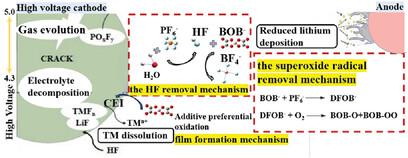当前位置:
X-MOL 学术
›
Adv. Energy Mater.
›
论文详情
Our official English website, www.x-mol.net, welcomes your
feedback! (Note: you will need to create a separate account there.)
Prospective Application, Mechanism, and Deficiency of Lithium Bis(oxalate)Borate as the Electrolyte Additive for Lithium-Batteries
Advanced Energy Materials ( IF 24.4 ) Pub Date : 2023-07-30 , DOI: 10.1002/aenm.202301422 Jianing Li 1 , Jianzhong Yang 2 , Zhaoqi Ji 3 , Min Su 4 , Huijing Li 1 , Yanchao Wu 1 , Xin Su 5 , Zhengcheng Zhang 6
Advanced Energy Materials ( IF 24.4 ) Pub Date : 2023-07-30 , DOI: 10.1002/aenm.202301422 Jianing Li 1 , Jianzhong Yang 2 , Zhaoqi Ji 3 , Min Su 4 , Huijing Li 1 , Yanchao Wu 1 , Xin Su 5 , Zhengcheng Zhang 6
Affiliation

|
Lithium bis(oxalate)borate (LiBOB) is one of the most common film-forming electrolyte additives used in lithium ion batteries (LIBs), since it can form a dense boron-containing polymer as a solid electrolyte interlayer (or cathode electrolyte interlayer) in order to isolate the electrode material from the electrolyte and prevent side reactions. LiBOB can serve as HF scavenger to maintain the structural integrity of electrodes via avoiding the transition metal dissolution caused by HF attack. LiBOB also can react with LiPF6 to generate lithium difluoro (oxalate)borate (LiDFOB) that can be further used as a clean-up agent for reactive oxygen radicals. This article lists the application of LiBOB in high capacity and high voltage cathode materials, and also reviews the working mechanisms of LiBOB used in these materials to improve the performance of LIBs. Finally, it presents the current shortcomings of LiBOB and strategies to overcome these. This article is expected to provide useful insights for employing LiBOB as a feasible method of dealing with the difficulty of running high capacity LIBs stably under high voltage.
中文翻译:

双(草酸)硼酸锂作为锂电池电解质添加剂的应用前景、机理及不足
双(草酸)硼酸锂(LiBOB)是锂离子电池(LIB)中最常用的成膜电解质添加剂之一,因为它可以形成致密的含硼聚合物作为固体电解质中间层(或阴极电解质中间层)以将电极材料与电解液隔离并防止副反应。LiBOB可以作为HF清除剂,通过避免HF侵蚀引起的过渡金属溶解来保持电极的结构完整性。LiBOB也能与LiPF 6反应生成二氟(草酸)硼酸锂(LiDFOB),可进一步用作活性氧自由基的清除剂。本文列出了LiBOB在高容量、高电压正极材料中的应用,并回顾了LiBOB在这些材料中使用以提高LIB性能的工作机制。最后,提出了LiBOB目前的缺点以及克服这些缺点的策略。本文有望为利用LiBOB作为解决高容量LIB在高电压下稳定运行的难题的可行方法提供有用的见解。
更新日期:2023-07-30
中文翻译:

双(草酸)硼酸锂作为锂电池电解质添加剂的应用前景、机理及不足
双(草酸)硼酸锂(LiBOB)是锂离子电池(LIB)中最常用的成膜电解质添加剂之一,因为它可以形成致密的含硼聚合物作为固体电解质中间层(或阴极电解质中间层)以将电极材料与电解液隔离并防止副反应。LiBOB可以作为HF清除剂,通过避免HF侵蚀引起的过渡金属溶解来保持电极的结构完整性。LiBOB也能与LiPF 6反应生成二氟(草酸)硼酸锂(LiDFOB),可进一步用作活性氧自由基的清除剂。本文列出了LiBOB在高容量、高电压正极材料中的应用,并回顾了LiBOB在这些材料中使用以提高LIB性能的工作机制。最后,提出了LiBOB目前的缺点以及克服这些缺点的策略。本文有望为利用LiBOB作为解决高容量LIB在高电压下稳定运行的难题的可行方法提供有用的见解。






























 京公网安备 11010802027423号
京公网安备 11010802027423号